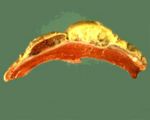Difference between revisions of "Traumatic Reticulitis"
| Line 3: | Line 3: | ||
==Description== | ==Description== | ||
Due to their unselective feeding habits, cattle may injest a variety of foreign bodies. Heavier metallic objects consumed can become lodged in the [[The Reticulum - Anatomy & Physiology|reticulum]], and may penetrate the reticular wall under the influence of the continuous [[The Reticulum - Anatomy & Physiology#Ruminoreticular contraction|reticular movements]]. | Due to their unselective feeding habits, cattle may injest a variety of foreign bodies. Heavier metallic objects consumed can become lodged in the [[The Reticulum - Anatomy & Physiology|reticulum]], and may penetrate the reticular wall under the influence of the continuous [[The Reticulum - Anatomy & Physiology#Ruminoreticular contraction|reticular movements]]. | ||
| − | + | Pathological changes depend on the direction of penetration; this is usually in an anterior-ventral direction. Pyogenic bacteria escape from the [[The Reticulum - Anatomy & Physiology|reticulum]], causing localised peritonitis, local fibrinous adhesions | |
| − | + | # Penetration of the diaphragm and pericardium resulting in [[Pericarditis|pericarditis]].Penetration of the heart itself resulting in myocarditis and endocarditis | |
| + | Penetration of the lungs and pleura resulting in pneumonia and pleurisy | ||
| + | Liver and splenic abscesses | ||
==Signalment== | ==Signalment== | ||
==Diagnosis== | ==Diagnosis== | ||
| Line 17: | Line 19: | ||
====Pathology==== | ====Pathology==== | ||
| + | Pericardium is enormously thickened with oedema, and purulent fluid containing fibrin clots accumulates in the sac giving “bread and butter heart” - classical traumatic reticulitis.[[Image:traumatic pericarditis.jpg|thumb|right|150px|Traumatic pericarditis (Courtesy of BioMed Image Archive)]] | ||
| + | Large abscesses in the dorsal part of the [[Liver - Anatomy & Physiology|liver]] may erode into posterior vena cava to produce thrombosis. | ||
| + | |||
| − | * | + | * * Very thick-walled, pus-filled abscesses form around points of penetration, which may be multiple. |
| − | |||
| − | |||
| − | |||
| − | |||
| − | |||
| − | |||
| − | |||
| − | |||
| − | * Very thick-walled, pus-filled abscesses form around points of penetration, which may be multiple. | ||
* The foreign object may be found in one of these abscesses, or free in the reticular lumen[[Category:Forestomach - Inflammatory Pathology]][[Category:Cattle]][[Category:To_Do_-_Caz]] | * The foreign object may be found in one of these abscesses, or free in the reticular lumen[[Category:Forestomach - Inflammatory Pathology]][[Category:Cattle]][[Category:To_Do_-_Caz]] | ||
Revision as of 15:35, 11 August 2010
| This article is still under construction. |
Description
Due to their unselective feeding habits, cattle may injest a variety of foreign bodies. Heavier metallic objects consumed can become lodged in the reticulum, and may penetrate the reticular wall under the influence of the continuous reticular movements. Pathological changes depend on the direction of penetration; this is usually in an anterior-ventral direction. Pyogenic bacteria escape from the reticulum, causing localised peritonitis, local fibrinous adhesions
- Penetration of the diaphragm and pericardium resulting in pericarditis.Penetration of the heart itself resulting in myocarditis and endocarditis
Penetration of the lungs and pleura resulting in pneumonia and pleurisy Liver and splenic abscesses
Signalment
Diagnosis
Clinical Signs
Signs are often vague, but adult cattle show abdominal pain with hunched backs and grunting on the "bar test".
Pathogenesis
- Cattle cannot spit out metallic agents (e.g. screws, nails, pieces of wire, bottle tops)once in their mouths, and so ingest them.
- Objects often become sharper in the reticulum due to reticular juices.
- Object penetrates through reticulum wall due to reticular movements. This is enhanced in pregnancy and parturition.
Pathology
Pericardium is enormously thickened with oedema, and purulent fluid containing fibrin clots accumulates in the sac giving “bread and butter heart” - classical traumatic reticulitis.
Large abscesses in the dorsal part of the liver may erode into posterior vena cava to produce thrombosis.
- * Very thick-walled, pus-filled abscesses form around points of penetration, which may be multiple.
- The foreign object may be found in one of these abscesses, or free in the reticular lumen
